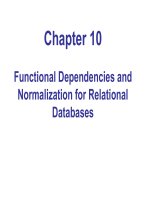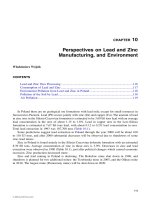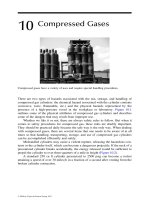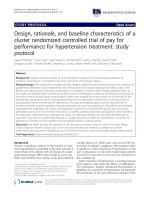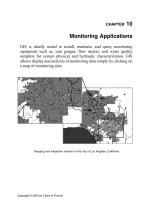HRM 5th chapter 10 pay for performance incentive rewards
Bạn đang xem bản rút gọn của tài liệu. Xem và tải ngay bản đầy đủ của tài liệu tại đây (539.78 KB, 45 trang )
Pay-for-Performance:
Incentive Rewards
Managing Human Resources
Belcourt * Bohlander * Snell
5th Canadian edition
PowerPoint Presentation by
Copyright © 2008 by Nelson, a division of Thomson
Canada Limited. All rights reserved.
Monica Belcourt, York University and
Charlie Cook, The University of West Alabama
Objectives
After studying this chapter, you should be able to:
1. Discuss the basic requirements for successful
implementation of incentive programs.
2. Identify the types of, and reasons for
implementing, individual incentive plans.
3. Explain why merit raises may fail to motivate
employees adequately and discuss ways to
increase their motivational value.
4. Indicate the advantage of each of the principal
methods used to compensate salespeople.
Copyright © 2008 by Nelson, a
10–2
Objectives
(cont’d)
After studying this chapter, you should be able to:
5. Differentiate how gains may be shared with
employees under the Scanlon, Rucker, and
Improshare gainsharing systems.
6. Differentiate between profit-sharing plans and
explain advantages and disadvantages of these
programs.
7. Describe the main types of ESOP plans and discuss
the advantages of ESOP to employers and
employees.
Copyright © 2008 by Nelson, a
10–3
Strategic Reasons for Incentive Plans
• Variable Pay
Tying pay to some measure of individual, group, or
organizational performance.
• Incentive Pay Programs
Establish a performance “threshold” to qualify for
incentive payments.
Emphasize a shared focus on organizational
objectives.
Create shared commitment in that every individual
contributes to organizational performance and
success.
Copyright © 2008 by Nelson, a
10–4
Types of Incentive Plans
INDIVIDUAL
GROUP
ENTERPRISE
Piecework
Team compensation
Profit sharing
Standard hour plan
Scanlon Plan
Stock options
Bonuses
Rucker Plan
Merit pay
Improshare
Lump-sum merit pay
Earnings-at-risk
plans
Employee
stock
ownership
plans (ESOPs)
Incentive awards
Sales incentives
Incentives for
professional
employees
Executive
compensation
Figure 10.1
Copyright © 2008 by Nelson, a
10–5
Incentive Plans as Links to
Organizational Objectives
• Incentive Plan Purposes
Encourage employees to assume “ownership” of their
jobs, thereby improving effort and job performance.
Motivate employees to expend more effort than under
hourly and/or seniority-based compensation systems.
Support a compensation strategy to attract and retain
top-performing employees.
• Incentive Plan Effectiveness
There is evidence of a relationship between incentive
plans and improved organizational performance.
Copyright © 2008 by Nelson, a
10–6
Advantages of Incentive Pay Programs
• Incentives focus employee efforts on specific performance targets. They
provide real motivation that produces important employee and
organizational gains.
• Incentive payouts are variable costs linked to the achievement of results.
Base salaries are fixed costs largely unrelated to output.
• Incentive compensation is directly related to operating performance. If
performance objectives (quantity and/or quality) are met, incentives are
paid. If objectives are not achieved, incentives are withheld.
• Incentives foster teamwork and unit cohesiveness when payments to
individuals are based on team results.
• Incentives are a way to distribute success among those responsible for
producing that success.
• Incentives are a means to reward or attract top performers when salary
budgets are low.
Figure 10.3
Copyright © 2008 by Nelson, a
10–7
Employee Opposition to Incentive Plans
• Production standards are set unfairly.
• Incentive plans are really “work speedup.”
• Incentive plans create competition among
workers.
• Increased earnings result in tougher standards.
• Payout formulas are complex and difficult to
understand.
• Incentive plans cause friction between
employees and management.
Copyright © 2008 by Nelson, a
10–8
Successful Incentive Plans
• Employees have a desire for an incentive plan.
• Employees are encouraged to participate.
• Employees see a clear connection between the incentive
payments they receive and their job performance.
• Employees are committed to meeting the standards.
• Standards are challenging but achievable.
• Payout formulas are simple and understandable.
• Payouts are a separate, distinct part of compensation.
Copyright © 2008 by Nelson, a
10–9
Highlights in HRM
Assessing Incentive Program Effectiveness
Highlights 10.1
Source: Christian M. Ellis and Cynthia L. Paluso, “Blazing a Trail to Broad-Based Incentives,” WorldatWork
Journal 9, no. 4 (Fourth Quarter 2000): 33–41. Used with permission, WorldatWork, Scottsdale, Arizona.
Copyright © 2008 by Nelson, a
10–10
Highlights in HRM
Setting Performance Measures—The Keys
• Performance measures—at all organizational levels—
must be consistent with the strategic goals of the
organization.
• Define the intent of performance measures and
champion the cause relentlessly.
• Involve employees.
• Consider the organization’s culture and workforce
demographics when designing performance measures.
• Widely communicate the importance of performance
measures.
Highlights 10.2
Copyright © 2008 by Nelson, a
10–11
Effective Incentive Plan Administration
• Grant incentives based on individual
performance differences.
• Have the financial resources to reward
performance.
• Set clearly defined, accepted, and challenging
yet achievable performance standards.
• Use an easily understood payout formula
• Keep administrative costs reasonable.
• Do not “ratchet up” performance standards.
Copyright © 2008 by Nelson, a
10–12
Individual Incentive Plans
• Straight Piecework
An incentive plan under which employees receive a
certain rate for each unit produced.
• Differential Piece Rate
A compensation rate under which employees whose
production exceeds the standard amount of output
receive a higher rate for all of their work than the rate
paid to those who do not exceed the standard
amount.
Copyright © 2008 by Nelson, a
10–13
Computing the Piece Rate
60 minutes (per hour)
12 minutes(standard time per unit)
$7.50 (hourly rate)
= 5 units per hour
= $1.50 per unit
5 units (per hour)
Copyright © 2008 by Nelson, a
10–14
Piecework: The Drawbacks
• Problems with piecework systems:
Is not always an effective motivator
Piecework standards can be difficult to develop.
Individual contributions can be difficult measure.
Not easily applied to work that is highly mechanized
with little employee control over output.
Piecework may conflict with organizational culture
(teamwork) and/or group norms (“rate busting”).
When quality is more important than quantity.
When technology changes are frequent.
Copyright © 2008 by Nelson, a
10–15
Individual Incentive Plans:
• Standard Hour Plan
An incentive plan that sets pay rates based on the
completion of a job in a predetermined “standard
time.”
If employees finish the work in less than the expected
time, their pay is still based on the standard time for
the job multiplied by their hourly rate.
Copyright © 2008 by Nelson, a
10–16
Bonuses
• Bonus
Incentive payment that is supplemental to the
base wage for cost reduction, quality
improvement, or other performance criteria.
• Spot bonus
Unplanned bonus given for employee effort
unrelated to an established performance
measure.
Copyright © 2008 by Nelson, a
10–17
Merit Pay
• Merit Pay Program (merit raise)
Links an increase in base pay to how successfully an
employee achieved some objective performance
standard.
• Merit Guidelines
Guidelines for awarding merit raises that are tied to
performance objectives.
Copyright © 2008 by Nelson, a
10–18
Highlights in HRM
Merit Pay Guidelines Chart
A merit pay guidelines chart is a “lookup” table for awarding merit
increases on the basis of
(1) employee performance,
(2) position in the pay range,
(3) time since the last pay increase.
Concerns:
What should unsatisfactory performers be paid?
What should average performers be paid?
How much should superior or outstanding performers be paid?
Copyright © 2008 by Nelson, a
Highlights 10.3
10–19
Problems with Merit Raises
• Money available for merit increases may be inadequate to
satisfactorily raise all employees’ base pay.
• Managers may have no guidance in how to define and measure
performance; there may be vagueness regarding merit award
criteria.
• Employees may not believe that their compensation is tied to
effort and performance; they may be unable to differentiate
between merit pay and other types of pay increases.
• The performance appraisal objectives of employees and their
managers are often at odds.
• There may be a lack of honesty and cooperation between
management and employees.
• Merit pay plans do not necessarily motivate higher levels of
employee performance.
Copyright © 2008 by Nelson, a
10–20
Motivation Through Merit Raises
• Develop employee confidence and trust in
performance appraisal.
• Establish job-related performance criteria.
• Separate merit pay from regular pay.
• Distinguish merit raises from cost-of-living
raises.
• Withhold merit payments when performance
declines.
Copyright © 2008 by Nelson, a
10–21
Lump-Sum Merit Pay
• Lump-sum Merit Program
Program under which employees receive a year-end
merit payment, which is not added to their base pay.
Advantages
Provides financial control by maintaining annual salary
expenses and not escalating base salary levels.
Contains employee benefit costs for levels of benefits normally
calculated from current salary levels.
Provides a clear link between pay and performance.
Copyright © 2008 by Nelson, a
10–22
Incentive Awards and Recognition
• Awards
Often used to recognize productivity gains, special
contributions or achievements, and service to the
organization.
Employees feel appreciated when employers tie
awards to performance and deliver awards in a timely,
sincere and specific way.
• Noncash Incentive Awards
Are most effective as motivators when the award is
combined with a meaningful employee recognition
program.
Copyright © 2008 by Nelson, a
10–23
Sales Incentives
Sales Incentive Plans
Straight Salary
Straight Commission
Salary and Commission
Combinations
Copyright © 2008 by Nelson, a
10–24
Incentive Plans for Salespersons
• Straight Salary Plan
Compensation plan that permits salespeople to be
paid for performing various duties that are not
reflected immediately in their sales volume.
Encourages building customer relationships.
Provides compensation during periods of poor sales.
May not provide sufficient motivation for maximizing sales
volume.
Copyright © 2008 by Nelson, a
10–25
